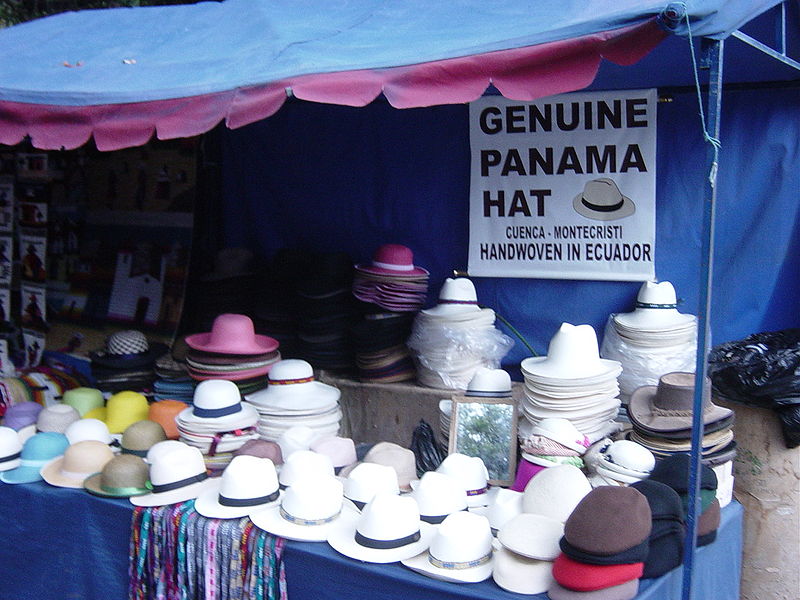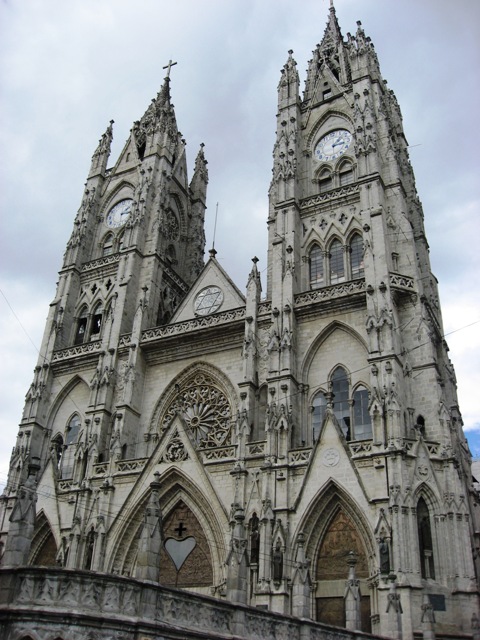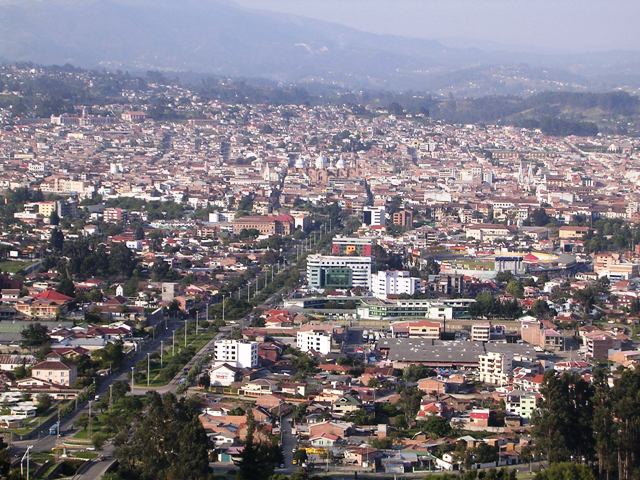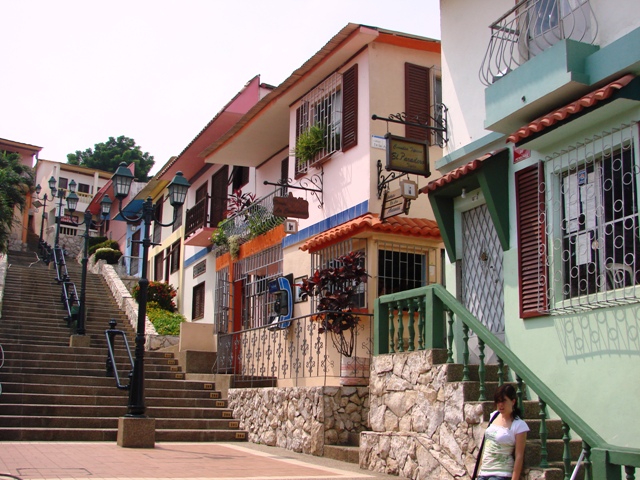WORLD TRAVEL NEWS ARTICLE
ECUADOR
The US dollar became the official currency, following IMF intervention when the former sucre/centavos currency collapsed in the monetary crisis of 2000. (The sucre was named for Antonio Jose de Sucre, a national hero). For the current exchange rates visit www.xe.com
Languages spoken are Spanish and Quechua. The national traditional dish is roast cuy (guinea pig).
Mariscal Sucre International Airport is located about 18 kilometres (11 miles) east of Quito. It replaces Old Mariscal Sucre International Airport. The airport became operational on 19 February 2013. For the latest visa requirements visit www.projectvisa.com
A potted history of Ecuador reminds us that in 1460 the Incas conquered the Indigenous Peoples; in 1533 the Spanish Conquistadores conquered the Incas and in 1822 Ecuador gained Independence within the Republic of Venezuela, Ecuador and Columbia. In 1822 Simon de Bolivar arrived in Quito. In 1830 Sucre was assassinated, Bolivar died in exile and General Juan Flores announced the country’s status as a Republic. In 2007, Socialist President Rafael Correa took office following success in the elections.
Ecuador comprises four regions, all so distinct from one another as to be almost like four separate countries.
• The spine of the Andes mountain range runs north/south in a double chain, leaving a fertile plateau between, known as the Sierra
• To the west, almost a quarter of the country occupies the Coast
• East of the Sierra lies the Amazonian jungle and rainforest
• 600 miles off the coast are the Galapagos Islands, which came under the jurisdiction of Ecuador in 1832.
The variety in altitude reflects a corresponding variety in temperature in Ecuador. The coast is generally warm and humid; average annual temperatures being 26°C. The Sierra sees temperatures range between 7°C and 21°C and in the city of Quito 13°C is the annual average. The East is much hotter and there is considerably more humidity – the annual average temperature is 38°C.
In Ecuador the sun is very powerful. Due to being at latitude 0 degrees, the rays fall vertically. It is absolutely essential to wear a hat and to apply high factor sun cream, even on a cloudy day. Exposure to the sun is more dangerous at high altitudes.

A good excuse and plenty of opportunities to purchase a Panama hat
A sad statistic is that deforestation has occurred faster in Ecuador than anywhere else, but despite the poverty within the country, stringent efforts have been made by national as well as international conservationists to preserve parks and reservations. The Galapagos Islands themselves are an almost 100% protected zone.
There are three major cities: Quito, Guayaquil and Cuenca.
Quito, at 2,850 metres above sea level, is situated at the foot of Pichincha Volcano. Its cool, restful, beautiful and historic old city offers a slower pace of life. Squares, monuments, green roof-tiled buildings whitewashed in the colonial style and numerous churches are to be admired. The church, La Compania de Jesus, is a 16th century example of the Baroque style with a huge quantity of gold – estimated at over 7 tons – and includes a solid gold altar. The Incas were sun worshippers, and the Conquistadores, who wanted to convert them to Christianity, tried to lure them into their churches by filling them with sun coloured gold.
In the modern part of the city, the most photographed sculpture is that of the giant corn on the cob.

Mitad de Mundo (Middle of the World) monument in Quito
Visit the “middle of the world” centre, where you can see the exact line, according to the GPS, of the equator. Due to the loss of gravity at 0 degrees, it is impossible to “walk the line” with your eyes closed – you will fall either to one side or the other. Water in the sink turns clockwise as it drains away in the southern hemisphere, anticlockwise in the northern. On the equator it goes straight down.
Another 0 degree phenomenon is that sunrise and sunset each lasts only minutes on the equator – the fastest on the planet.
Old Quito offers a lovely walking tour of cobbled lanes, balconies, and colonial mansions. Start in the Plaza de la Independencia where the San Francisco Church houses the statue of Our Lady of Quito. Look at the Presidential Palace where the guards wear 19th century uniforms of red, blue and gold. Visit the cathedral where Sucre is buried and the Casa de Sacre Museo Historico, his former home, now a museum. His floodlit statue stands in the Plaza San Domingo. The church of San Domingo is dedicated to St Jude (patron saint of hopeless cases) and people pray and leave a note of thanks when appropriate.

The Basilica del Voto Nacional, Quito
Bird watching tours are available (an incredible number of bird species thrive in Ecuador, including kites, albatross, frigates, vultures, eagles and humming birds); visits to the thermal spring bathing pools are popular, as are hikes for the active who are rewarded with a stunning cloud forest, lush vegetation and unbeatable views. Tourist trains run between Quito to Guayaquil, and offer a more leisurely way of savouring the beauties of the rainforest.
From Quito you can visit the still active Cotapaxi Volcano, which is quite awe inspiring not only for all that activity going on beneath the surface but also because of its setting in a natural wonderland of flourishing flora and fauna and especially because of the sheer number of different bird species you will see.
Go north to visit Otavalo and its affluent hard working inhabitants, the Otavalenos, whose exquisite weaving is exported worldwide. Here, the Saturday market of vegetables, animals and crafts is a haven for souvenir seekers and the quality of woven goods is very high. Leather goods are also on sale. You will see many people wearing colourful costumes with stunning hats, including bowlers. The Otavalenos smile a lot and are friendly but a little shy. You will see women carrying everything on their backs, from babies and children to potatoes or the shopping.

Cuenca
Nearer to Cuenca in the south of the Sierra, the train ride to Devil’s Nose is an astounding feat of engineering and it is on this line that you can ride on the roof of the train. Cuenca is very Spanish with a lot of tin to be seen in the architecture and balconies made of iron. This is the third most important city and is mainly concerned with commerce and industry. Tourism also plays an important part in its economy.
In the province of Tunurahua the city of Ambato celebrates the harvest with a February Fiesta of Fruit and Flowers. This is very colourful and the heady smells of the fruit and blossoms make it a highly scented occasion. The variety of fruit is endless, but you will see plenty of pineapples, melons, plums and passion fruit.
In the east the oil is running out and the numerous indigenous tribes are under threat. The Parque Nacional offers jungle lodges and eco tours, so tourism, may have devastating consequences in the long term, does offer some short term solutions.

Las Penas, Santa Anna, Guayaquil
The largest city in Ecuador is Guayaquil on the west coast. Industrialised and commercially orientated, it nevertheless relies on agriculture, and exports bananas, cocoa, coffee and sugar. More than three million people live in Guayaquil and if you need to escape the turmoil, a visit to Parque Bolivar Botanical Gardens will undoubtedly soothe you.
Coastal resorts abound, and if you can, you should try to fit in a day or two to relax in a hammock, gazing out to the Pacific, while recharging your batteries.
A visit to Manta on the west coast is worthwhile as this pretty little place is in the centre of the Panama hat making villages. As well as panama hats you will see sisal hammocks and wickerwork furniture being made.

Yes, properly made ones really do fold up
The making of hats started when local people used local reeds in order to weave waterproof, fold-up headwear, and it developed as a cottage industry. Because the hats were shipped from Panama they acquired the name but they were always made in Ecuador. Nowadays each one can take up to three months to make, and can cost in excess of US$1,000. Fashion has moved away from Panama hats these days and the industry may yet cease to exist.
Finally, a visit to the Galapagos Islands is totally unforgettable. All 61 islands enjoy National Park status. Visitors are charged a hefty fee in excess of US$100 for the privilege of going there.

Albatros at play
The experience is worth every penny, as you will see a whole host of animals from iguanas to flamingos, not tame, but not timid either, and you take a step back in time to an understanding of how these unspoiled islands and their creatures must have looked when Darwin visited on the Beagle, in 1835. He realised at once what he was seeing in this protected and isolated place, and thus were born his theories of evolution and mutation.
In 2007 The Galapagos Islands joined the list of the UN’s World Heritage Sites in Danger, which eventually means a reduction in the number of tourists being allowed access, so don’t delay.
For information concerning weather conditions visit www.worldweather.org
You may also like to read

BRAZIL - South America
Tour-smart travellers will already know that the excitement is building in the massive country.

CHILE - South America
Long, diverse and fascinating, Tour-smart introduces you to Chile, a ribbon of land 2,700 miles long on the Pacific coast of South America.


Comments